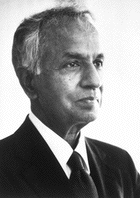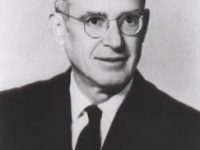
Subrahmanyan Chandrasekhar (1910-1995)
On October 19, 1910, Indian-American astrophysicist and Nobel Laureate Subrahmanyan Chandrasekhar was born. He won the 1983 Nobel Prize for Physics together with William Alfred Fowler for key discoveries that led to the currently accepted theory on the later evolutionary stages of massive stars. Actually, winning Nobel Prizes in physics must lie somehow in the family of Chandrasekhar, because his uncle Sir Chandrasekhara Venkata Raman won the Nobel Prize for Physics already in 1930, too.[4]
Where the mind is without fear and the head is held high;
Where knowledge is free;
Where words come out from the depth of truth;
Where tireless striving stretches its arms towards perfection;
Where the clear stream of reason has not lost its way into the dreary desert sand of dead habit;
into that haven of freedom, Let me awake.
( from Gitanjali, a poem by Rabindranath Tagore, cited by Chandrasekhar in his 1983 Nobel Prize banquet speech)[5]
How do Stars Evolve?
The important scientific contribution, for which Chandrasekhar received his Nobel Prize concerns a rather fundamental topic for our universe. How do stars evolve and what happens to stars, when they are rather massive, i.e. much more massive than our own Sun. You should know that the way, how a star is evolving in its later stage, depends on its mass. And this is, what Chandrasekhar did come up with: he showed that there is a maximum mass which can be supported against gravity by pressure made up of electrons and atomic nuclei. The value of this limit is about 1.44 times the mass of our Sun. This was already derived by Chandrasekhar in 1930, when he was a student. The so-called Chandrasekhar Limit plays a crucial role in understanding the stellar evolution. If the mass of a star exceeded this limit, the star would not become a white dwarf, i.e. a stellar remnant composed mostly of electron-degenerate matter. It would continue to collapse under the extreme pressure of the gravitational forces of its own mass. The astrophysicist Arthur Eddington, who was important at the time, saw this as contradictory to his findings and fought Chandrasekhar not only scientifically but also on a personal level.[11]
The Chandrasekhar Limit
The formulation of the Chandrasekhar Limit led to the discovery of neutron stars and black holes. For almost all the time of their live, stars are stable, that is they do not collapse because internal pressures balance gravity. The internal pressure in a star stems from the thermal motion of the atomic nuclei and electrons and also from the pressure of the radiation generated by nuclear reactions. However, for every star a time will come when nuclear reactions will cease and that means there will be no internal pressure to match the gravitational pull of its mass. Depending on the mass of the star, we know that there are three possible final stages of a star: white dwarf, neutron star and black hole.
Subrahmanyan Chandrasekhar – Background
Subrahmanyan Chandrasekhar was known throughout his life simply as Chandra. Born on October 19, 1910 to C Subrahmanyan Ayyar, an Indian government auditor whose job was to audit the Northwest Railways and Sitalaksmi Aiyar in a large family, having two older sisters, three younger brothers and four younger sisters. Although he was supposed to follow his father into government service, Chandra wanted to be a scientist and his mother encouraged him to follow this route. Actually his uncle Sir Chandrasekhara Venkata Raman was some kind of a role model for him and Chandra studied at Presidency College, University of Madras. In July 1930, Chandra was awarded a Government of India scholarship to pursue graduate studies at the University of Cambridge, where he was admitted to Trinity College.
Graduation and the Eddington Incident
In his first year at Cambridge, Chandra was already introduced to the monthly meetings of the Royal Astronomical Society. At the invitation of Max Born he spent the summer of 1931, at Born’s institute at Göttingen.[6] On the advice of Paul A. M. Dirac,[7] he spent his final year of graduate studies at the Institute for Theoretical Physics in Copenhagen, where he met Niels Bohr.[8] He finished his PhD in 1933 with a thesis among his four papers on rotating self-gravitating polytropes and was elected to a Prize Fellowship at Trinity College for the period 1933–37. In an infamous encounter at the Royal Astronomical Society in London in 1935, Eddington publicly ridiculed the concept of the Chandrasekhar limit. Although Eddington would later be proved wrong by computers and the first positive identification of a black hole in 1972, this encounter caused Chandrasekhar to contemplate employment outside the UK. Later in life, on multiple occasions, Chandrasekhar expressed the view that Eddington’s behavior was in part racially motivated.
Later Life
In 1937, Chandra was recruited to the University of Chicago, where he remained for his entire career until attaining emeritus status in 1985. He often presented his research results in monographs, such as “Introduction to the study of stellar structure” (1939), “Dynamics of stellar systems” (1943), “Radiative transfer” (1950), “Hydrodynamic stability” (1961), “Ellipsoidal Figures of Equilibrium” (1969) or the mathematical theory of black holes (1983). In 1983 he received the Nobel Prize in Physics “for his theoretical studies of the physical processes involved in the structure and evolution of stars“. In 1999, NASA named the third of its four “Great Observatories” after Chandrasekhar. In 1995 he published an edition of Newton’s Principia, which he provided with a detailed commentary – “Newton’s Principia for the Common Reader“. American astronomer and science communicator Carl Sagan,[9] who studied Mathematics under Chandrasekhar, at the University of Chicago, praised him in one of his books: “I discovered what true mathematical elegance is from Subrahmanyan Chandrasekhar.“
Alex Fillipenko, Exploding Stars – Celestial Fireworks!, [13]
References and Further Reading:
- [1] Biography of Subrahmanyan Chandrasekhar at Nobelprize.org
- [2] Autobiographical notes from Chandrasekhar
- [3] Biography of Subrahmanyan Chandrasekhar at MacTutor History of Mathematics
- [4] C. V. Raman and the Raman Effect, SciHi Blog
- [5] Reshaping India’s Literature – Rabindranath Tagore, SciHi Blog
- [6] Max Born and the statistical interpretation of the Wave Function, SciHi Blog
- [7] Paul Dirac and the Quantum Mechanics, SciHi Blog
- [8] Niels Bohr and the Origins of Quantum Mechanics, SciHi Blog
- [9] Carl Sagan’s Cosmos, SciHi Blog
- [10] Sir Arthur Eddington – The Man who Proved Einstein’s General Relativity, SciHi Blog
- [11] Subrahmanyan Chandrasekhar at Mathematics Genealogy Project
- [12] Subrahmanyan Chandrasekhar at Wikidata
- [13] Alex Fillipenko, Exploding Stars – Celestial Fireworks!, 2008, University of California Television (UCTV) @ youtube
- [14] Chandrasekhar, S. (1989). Selected Papers, Vol 1, Stellar structure and stellar atmospheres. Chicago: University of Chicago Press.
- [15] Chandrasekhar, S. (1989). Selected Papers, Vol 2, Radiative transfer and negative ion of hydrogen. Chicago: University of Chicago Press.
- [16] Chandrasekhar, S. (1989). Selected Papers, Vol 3, Stochastic, statistical and hydromagnetic problems in Physics and Astronomy. Chicago: University of Chicago Press.
- [17] Chandrasekhar, S. (1989). Selected Papers, Vol 4, Plasma Physics, Hydrodynamic and Hydromagnetic stability, and applications of the Tensor-Virial theorem. Chicago: University of Chicago Press.
- [18] Penrose, Roger (1996). “Chandrasekhar, Black Holes and Singularities”. Journal of Astrophysics and Astronomy. 17 (3–4): 213–231.
- [19] Timeline for Subrahmanyan Chandrasekhar, via Wikidata






Pingback: Whewell’s Gazette: Year 3, Vol. #10 | Whewell's Ghost